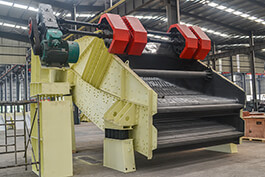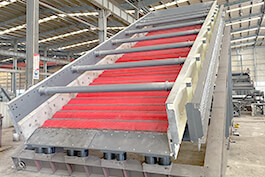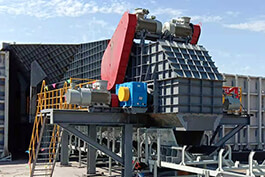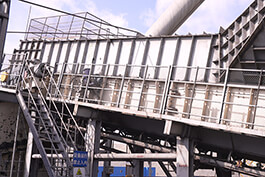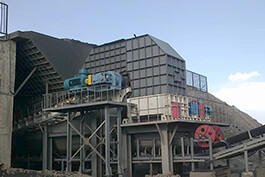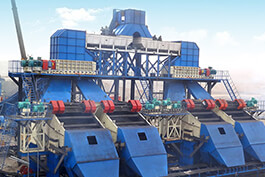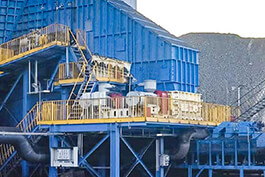Description of the equipment---Roller Screen
A Roller Screen is a device that uses multiple parallelly arranged, rotating cylindrical rollers in a certain direction to conduct material screening.
Working principle is as follows
When the material enters from the feed opening at the top of the device, it will fall onto these rotating rollers. There is a certain gap between the rollers, which constitutes the sieve hole size. Under the continuous rotation of the rollers, the material is subjected to the combined effect of gravity and the friction force of the rollers, moving forward along the axial or lateral direction of the rollers. During this process, the materials with particle sizes smaller than the gap (the screened material) will fall through the gap and enter the corresponding collection device; while the materials with particle sizes larger than the gap (the oversize material) will be transported by the rollers to the discharge outlet at the end of the device and be discharged.
The composition of the roller screen
The rollers of the Roller Screen are usually composed of an axle body and the screen plates or strips on the axle. The shape and arrangement of the screen plates can be designed according to needs to adapt to the screening characteristics of different materials. Its driving method is generally through a motor driven by a reducer to drive the sprocket or gear, thereby driving all the rollers to rotate synchronously or in a specific pattern.
Applications
This equipment is widely used in industries such as coal, mining, power, metallurgy, and building materials, mainly for grading and screening of block and granular materials to separate products of different particle sizes, meeting the requirements of subsequent processing, transportation, or use. It has the characteristics of simple structure, reliable operation, high screening efficiency, strong adaptability to materials (especially suitable for handling materials with high moisture content, high viscosity, or containing certain impurities, less likely to clog the sieve holes), and convenient maintenance. Depending on the properties of the processed materials, production requirements, and installation space conditions, the Roller Screen can be designed into different specifications and models, such as single-axis type, multi-axis type, inclined type, and horizontal type.
Effects of Rollers Speed Regime on the Roller Screen Efficiency
The influence of different rotational speeds of the screen shaft
Too low rotational speed
Insufficient conveying capacity, thick material layer: The rotational power of the roller shaft is not sufficient to quickly transport the materials forward, resulting in the accumulation of materials on the screen surface and forming a very thick material layer.
Difficult stratification: Fine particles are buried at the bottom of the thick material layer and have no chance to come into contact with the screen holes (screen gaps), thus unable to achieve effective screening. This is called "material layer effect" or "over-thick layer screening".
Easy clogging: For damp and sticky materials, the low-speed rotating roller shaft cannot provide sufficient shear force and throwing force to clean the screen holes, easily causing the materials to adhere to the roller shaft, resulting in screen hole clogging.
Low screening efficiency: Most fine particles are carried out before they can pass through the screen, becoming the material on the screen, resulting in low output of the material below the screen and a sharp decline in efficiency.
Phenomenon: There are still a large number of fine particles that should have become the material below the screen in the material on the outflow end of the roller screen.
The rotational speed is within the optimal range
The materials are fully loosened and stratified: The rollers rotate at an appropriate speed, exerting effective flipping and scattering effects on the materials, which causes the materials to be in a "semi-fluidized" state on the screen surface. Fine particles have the opportunity to sink to the bottom of the material layer and come into contact with the screen holes.
Optimized screening probability: The residence time of the materials on the screen surface (i.e., the screening time) is balanced with the forward speed, providing sufficient time for fine particles to pass through the screen while ensuring the processing capacity.
Self-cleaning effect: The appropriate rotational speed enables the rollers to generate a certain "slip-off" effect on the adhered materials, helping to keep the screen holes of the Rollers creen unobstructed.
Phenomenon: The screening is thorough, with the materials on the screen mainly being large particles, and the materials on the bottom of the screen are pure, and the output is stable.
Excessive rotational speed
Short material retention time: The material is "sprinted" from the feed end to the discharge end too quickly. The retention time on the sieve surface is too short, and fine particles are removed before they have a chance to pass through the sieve.
"Jumping" effect: The high rotational speed causes the material to be thrown up too high. Most of the time, it is flying in the air instead of rolling and contacting the sieve holes on the sieve surface. This greatly reduces the effective sieve-passing opportunities.
Particle fragmentation: For materials such as coke that are easily broken, excessive rotational speed and impact force will cause the material to be squeezed and impacted by the rollers and break, generating unnecessary powder and affecting product quality.
Increased wear and energy consumption of Roller Scree: High rotational speed means greater centrifugal force, more friction and impact, which will accelerate the wear of components such as the rollers, sieve plates and drives of the Roller scree, and at the same time, energy consumption will significantly increase.
Phenomenon: There are still many qualified particles that have not passed through the sieve in the sieve material, and there may also be excessive particle fragmentation.
Determination of the optimal rotation speed of the screen shaft
Theoretical critical rotation speed
In engineering, the concept of "critical rotation speed" is often referred to, which is the rotation speed at which the material begins to be thrown off on the Roller Screen. The optimal working rotation speed is usually designed within a certain percentage range of the critical rotation speed (for example, 60% - 85%), and it is related to the diameter of the roller, the installation inclination angle, and the material characteristics, etc.
Main influencing factors
Material characteristics
Particle size composition: Materials with a high content of fine particles may require a slightly lower rotational speed to extend the screening time.
Moisture content and viscosity: Damp and highly viscous materials require a higher rotational speed to generate stronger throwing and self-cleaning effects, preventing blockages.
Density and friction coefficient: Affect the fluidity of the material and its movement state on the Roller Screen.
Sieve machine structural parameters
Roller diameter: The larger the diameter, the lower the rotational speed required to achieve the same linear speed.
Sieve gap size: The smaller the target sieving particle size, the more precise control is usually needed, and the rotational speed may tend to be set at a lower level.
Installation inclination angle: The greater the inclination angle, the faster the material slides down due to gravity, and the required conveying rotational speed can be correspondingly reduced.
Processing capacity requirements: While ensuring efficiency, increasing the processing volume usually requires appropriately increasing the rotational speed.
.jpg)
Optimization of Roller Screen Parameters
Total length of roller screen and the number of rollers
Optimization Principles
The total length determines the screening time of the material. The number of screen shafts is the specific way to achieve the total length and the structure of the screen surface.
Screening time = Screen mesh length / The forward speed of the material on the screen surface.
Optimization Strategy
Balance between processing capacity and efficiency: A longer screen mesh means a longer screening time, which is beneficial for improving screening efficiency, but it also increases equipment costs and floor space. For difficult-to-screen materials (such as sticky and wet, fine-grained), a longer screen mesh is needed.
Number of screen shafts: Under the same total screen mesh length, increasing the number of screen shafts can reduce the increasing gradient of the gap between each screen shaft, making the screening process smoother, which is conducive to reducing jamming and blockages, especially for fragile materials. However, it also increases the complexity of drive and costs.
Suggestion
Based on the characteristics of the materials (viscosity, particle size, moisture content) and the required processing volume, the total length of the screen mesh is initially determined. This is usually done through experiments or by drawing on experience from similar projects.
For regular materials, the number of screen shafts is generally 5 to 15. For materials requiring high precision screening or those prone to clogging, the number of screen shafts can be appropriately increased, with a smaller variation rate of the gap.
Gap sizes of the screen shaft
Optimization Principles
The gap between the sieve shafts is the most critical parameter determining the separation particle size.
Optimization Strategy
Equal Gap: All sieve shaft gaps are the same. It is suitable for scenarios where the particle size distribution of the materials is concentrated and where the requirements for separation or classification are not high. The structure is simple.
Increasing Gap: The gap between the sieve shafts gradually increases from the feed end to the discharge end. This is the most commonly used method. The small gap end is responsible for screening out most fine materials, and the large gap end is responsible for transporting the qualified coarse materials out, and it can effectively prevent blockages.
Gap Setting: The target separation particle size d is usually set between the first gap and the last gap. For example, if you want to separate materials smaller than 10mm, the feed end gap can be set to 8mm, and the discharge end gap can be set to 12mm or 15mm. This ensures that the 10mm materials are separated in the rear part of the sieve surface and prevents large pieces of materials from getting stuck at the discharge port.
Suggestion
First, use an increasing gap.
The maximum gap should be greater than 1.2-1.5 times the maximum particle size of the feed material to ensure smooth discharge.
According to the particle size requirements of the product, precisely design the gap increment curve (it can be linearly increasing, or non-linearly increasing first fast then slow or first slow then fast).
Inclination of the roller screen
Optimization Principles
The inclination angle determines the forward speed of the material and the screening time.
Optimization Strategy
Large inclination angle: The material flows quickly, the processing capacity is high, but the screening time is short, which may lead to incomplete screening and a decrease in efficiency.
Small inclination angle: The material flows slowly, the screening time is long, the efficiency is high, but the processing capacity is limited, and it is prone to clogging due to the tendency of wet and sticky materials to adhere to the screen surface.
Suggestion
The typical inclination angle range of Roller Screen is 5° - 15°.
For dry and fluid materials: a smaller inclination angle (5° - 10°) can be selected to pursue high efficiency.
For wet and sticky materials that are prone to clogging: a larger inclination angle (10° - 15°) should be chosen, relying on gravity to assist the material flow and self-cleaning.
The inclination angle should be adjusted in coordination with the rotational speed of the screen shaft.
Roller angular velocity
Optimization Principles
Rotational speed affects the throwing intensity, forward speed, and self-cleaning effect of the materials.
Optimization Strategies
High rotational speed
Advantages: It has a strong throwing and rolling effect on the materials, which is beneficial for fine materials to pass through the screen, has a strong self-cleaning ability, and is less prone to clogging.
Disadvantages: The materials move too fast, reducing the screening time; high energy consumption, rapid wear, and loud noise; high fragmentation rate for fragile materials.
Low rotational speed
Advantages: The materials flow smoothly, the screening time is long, and the efficiency may be higher; low energy consumption and wear.
Disadvantages: Weak self-cleaning ability, prone to clogging; lower processing capacity.
Suggestion
The rotational speed is usually within an empirical range (such as 20 - 60 rpm), and the optimal point needs to be determined through experiments.
For sticky and wet materials, a higher rotational speed is required to ensure self-cleaning.
For dry and fragile materials, a lower rotational speed is adopted to reduce crushing and dust generation.
A frequency converter can be used to control the rotational speed, allowing it to be flexibly adjusted according to changes in the feed volume and material properties. This is one of the most effective optimization methods.
Feed rate
Optimization Principles
The feeding speed must be matched with the processing capacity of the screen.
Optimization Strategy
Feeding too fast: This will result in an overly thick material layer on the screen, with fine materials having no chance to come into contact with the screen surface and being carried away instead, severely reducing the screening efficiency. This is commonly known as "running coarse" and also increases the load and blocking risk of the Roller Screen.
Feeding too slow: This cannot fully utilize the screening capacity of the Roller Screen and is not economically viable.
Suggestion
Ensure that the feed is continuous, uniform and stable, and spread evenly along the width of the screen. The use of feeders (such as vibrating feeders, belt feeders) is crucial.
The optimal feed rate is one that can form a relatively thin layer of material on the screen surface. The specific thickness needs to be determined through experiments, and it is usually related to the screen width and the properties of the material.
Feed PSD
Optimization Principles
This is the fundamental input condition for the design. All other parameters need to be optimized around it.
Optimization Strategies
"Near-sieve particles" content: Refers to particles with a particle size near the target separation size d (such as 0.8d - 1.2d). These particles are the most difficult to sieve, and the higher the content, the longer the sieving time required (requiring a longer screen or a lower inclination/rotation speed).
Fine powder content: High fine powder content makes it easy to pass through the sieve, but it is also prone to dust and adhesion. The rotational speed and inclination angle need to be adjusted to control the dust while maintaining efficiency.
Large particle content: There is a lot of large material, which requires the rollers to have sufficient strength and torque, and the gap at the discharge end needs to be large enough.
Water content: This is one of the most important variables affecting the efficiency of the Roller Screen sieving. A slightly higher moisture content will cause the material to bond into lumps, blocking the sieve slots. At this time, a large inclination angle, high rotational speed, or even additional cleaning and blocking devices (such as bouncing balls, scrapers, etc.) must be adopted.


.jpg)
.jpg)
